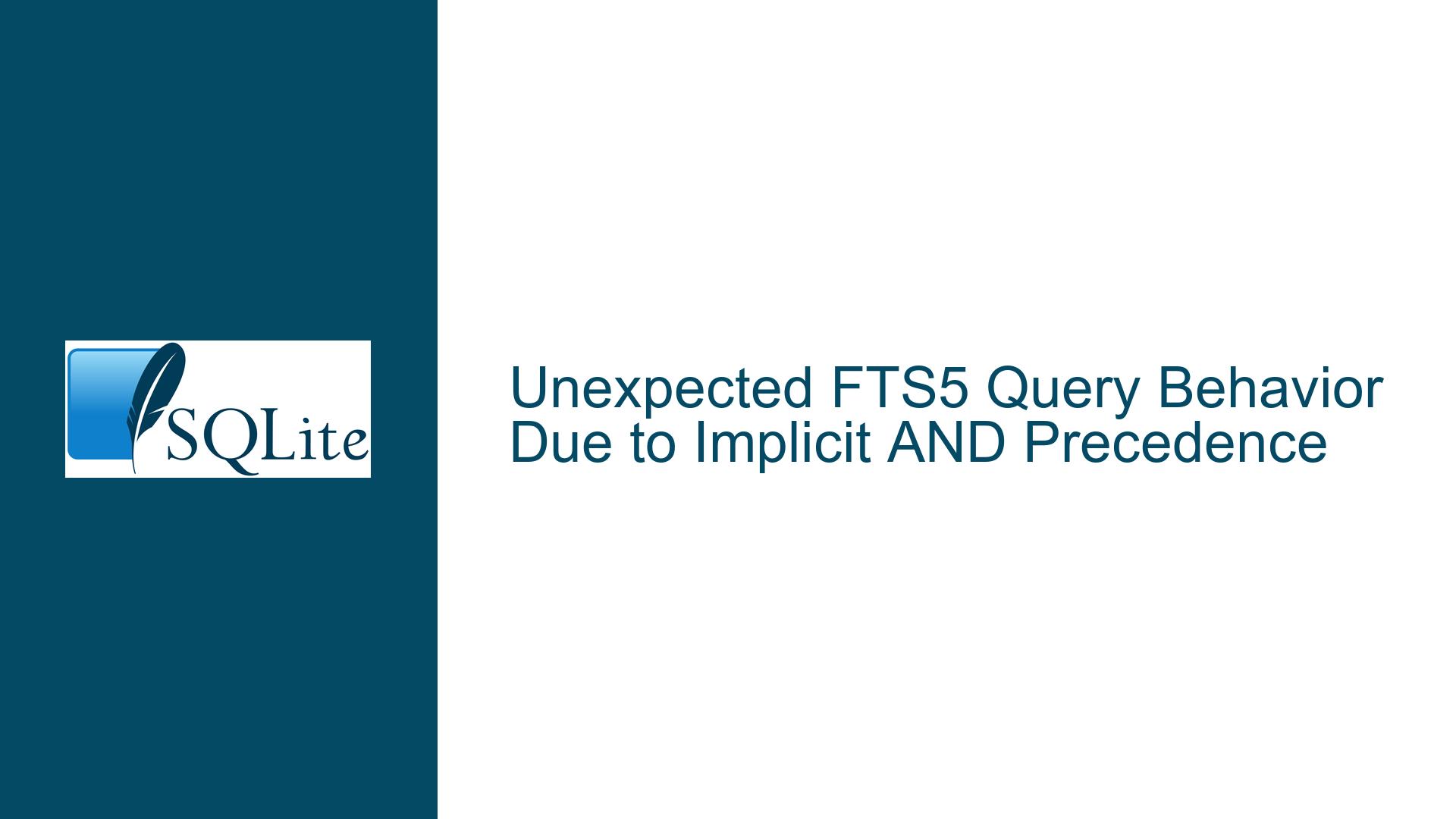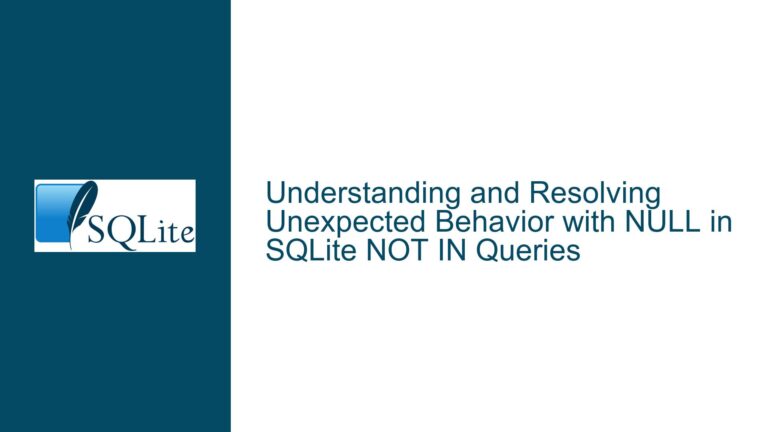Unexpected FTS5 Query Behavior Due to Implicit AND Precedence
Understanding FTS5 Query Parsing and Operator Precedence
The core issue revolves around the unexpected behavior of SQLite’s FTS5 (Full-Text Search) when executing queries involving the NOT operator and implicit AND operators. Specifically, the query 'spider NOT man foo' returns a match, while 'spider NOT man AND foo' does not, despite the expectation that both should behave similarly. This discrepancy stems from the parsing rules and operator precedence within FTS5, particularly how implicit AND operators are handled in relation to explicit operators like NOT.
To fully grasp the issue, it is essential to understand how FTS5 parses queries and assigns precedence to operators. FTS5 treats spaces between tokens as implicit AND operators, which means that a query like 'spider man foo' is interpreted as 'spider AND man AND foo'. However, when explicit operators like NOT are introduced, the parsing rules become more nuanced. The implicit AND operators group more tightly than explicit operators, meaning they have higher precedence. This tight grouping affects how the query is interpreted and executed.
For example, the query 'spider NOT man foo' is parsed as 'spider NOT (man AND foo)' due to the higher precedence of the implicit AND between 'man' and 'foo'. This results in the query matching any document that contains 'spider' but does not contain both 'man' and 'foo'. On the other hand, the query 'spider NOT man AND foo' is parsed as '(spider NOT man) AND foo', which matches documents that contain 'foo' and do not contain 'man', but also contain 'spider'. This difference in parsing leads to the observed behavior.
The Role of Implicit AND in FTS5 Query Interpretation
The implicit AND operator in FTS5 plays a critical role in query interpretation, often leading to confusion when combined with explicit operators like NOT. The implicit AND is inserted between tokens that are not explicitly connected by an operator, and it groups more tightly than explicit operators. This means that in a query like 'spider NOT man foo', the implicit AND between 'man' and 'foo' is evaluated before the NOT operator, resulting in the query being interpreted as 'spider NOT (man AND foo)'.
This behavior is consistent with the FTS5 documentation, which states that implicit AND operators group more tightly than all other operators, including NOT. However, this detail is not immediately obvious, especially to users who are not deeply familiar with the intricacies of FTS5 query parsing. The documentation could benefit from more explicit examples and explanations, particularly regarding the interaction between implicit AND and explicit operators like NOT.
To further illustrate, consider the query 'spider OR man foo'. According to the FTS5 parsing rules, this query is interpreted as 'spider OR (man AND foo)' due to the higher precedence of the implicit AND between 'man' and 'foo'. This means the query matches documents that contain either 'spider' or both 'man' and 'foo'. If the implicit AND did not have higher precedence, the query would be interpreted as '(spider OR man) AND foo', which would match documents that contain 'foo' and either 'spider' or 'man'.
Resolving Ambiguities and Improving Query Predictability
To avoid unexpected results when using FTS5 queries, it is crucial to understand the precedence rules and how they affect query interpretation. One effective way to ensure predictable behavior is to use parentheses to explicitly define the intended grouping of terms and operators. For example, the query 'spider NOT (man AND foo)' clearly indicates that the NOT operator should apply to the combination of 'man' and 'foo', while '(spider NOT man) AND foo' ensures that the NOT operator applies only to 'man' and the result is combined with 'foo'.
Additionally, the FTS5 documentation should be updated to include more detailed examples and explanations, particularly regarding the interaction between implicit AND and explicit operators like NOT. This would help users better understand the parsing rules and avoid common pitfalls. For instance, the documentation could include examples like the following:
'spider NOT man foo'is interpreted as'spider NOT (man AND foo)'.'spider NOT man AND foo'is interpreted as'(spider NOT man) AND foo'.'spider OR man foo'is interpreted as'spider OR (man AND foo)'.
By providing clear and explicit examples, the documentation can help users write more predictable and accurate queries, reducing the likelihood of unexpected results.
In conclusion, the unexpected behavior observed in FTS5 queries involving the NOT operator and implicit AND operators is a result of the parsing rules and operator precedence within FTS5. Understanding these rules and using parentheses to explicitly define the intended grouping of terms and operators can help avoid confusion and ensure predictable query results. Additionally, updating the FTS5 documentation to include more detailed examples and explanations would further assist users in writing effective and accurate queries.






